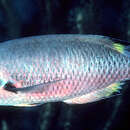Diagnostic Description
(
englanti
)
tarjonnut CoralReefFish
Diagnosis: The fin-ray count of D-XII,10 A-III,12 and Pect-17 indicates Clepticus parrae. Bodianus share the median-fin ray count, but have one fewer pectoral-fin ray and a different body shape. (U)
- lisenssi
- cc-by-3.0
- tekijänoikeus
- www.coralreeffish.com by Benjamin Victor
Diagnostic Description
(
englanti
)
tarjonnut Fishbase
Moderately elongate, compressed fish with equally curved upper and lower profiles (Ref. 26938). Color primarily violet or purple; large individuals with a wash of yellow on lower two-thirds of body; prolonged portions of dorsal and anal fins and tips of pelvic fins blackish (Ref. 13442). Caudal fin emarginate in young, lunate in adults (Ref 52831).
- lisenssi
- cc-by-nc
- tekijänoikeus
- FishBase
- Recorder
- Grace Tolentino Pablico
Life Cycle
(
englanti
)
tarjonnut Fishbase
Forms lek during breeding (Ref. 55367). A monandric species (Ref. 55367). Length at sex change = 15.78 cm TL (Ref. 55367).
- lisenssi
- cc-by-nc
- tekijänoikeus
- FishBase
Morphology
(
englanti
)
tarjonnut Fishbase
Dorsal spines (total): 12; Dorsal soft rays (total): 10; Analspines: 3; Analsoft rays: 12 - 13
- lisenssi
- cc-by-nc
- tekijänoikeus
- FishBase
- Recorder
- Grace Tolentino Pablico
Trophic Strategy
(
englanti
)
tarjonnut Fishbase
Cleaned by Pederson's cleaner shrimp (Periclimenes pedersoni), goby (Gobiosoma evelynae and others), hogfish (Bodianus rufus), and also wrasse (Thalassoma trifasciata) as observed on the coral reefs in Bonaire, Netherlands Antilles (Ref. 36810).
- lisenssi
- cc-by-nc
- tekijänoikeus
- FishBase
Biology
(
englanti
)
tarjonnut Fishbase
Inhabits seaward reef slopes; occasionally on shallow patch reefs (Ref. 9710). Found in large midwater aggregations feeding on plankton (Ref. 9710), small jellyfishes, pteropods, pelagic tunicates and various invertebrate larvae (Ref. 13442). Form leks during breeding (Ref. 55367). Also caught with beach nets (Ref. 5217).
- lisenssi
- cc-by-nc
- tekijänoikeus
- FishBase
Importance
(
englanti
)
tarjonnut Fishbase
fisheries: minor commercial; aquarium: commercial; price category: very high; price reliability: very questionable: based on ex-vessel price for species in this family
- lisenssi
- cc-by-nc
- tekijänoikeus
- FishBase
Creole wrasse
(
englanti
)
tarjonnut wikipedia EN
The creole wrasse (Clepticus parrae) is a species of wrasse native to the western Atlantic Ocean.
Description
The creole wrasse is a small wrasse, with males reaching around 30 cm (1 ft) in length, while females are smaller. It has a typical wrasse shape. Like many wrasse, it changes colour markedly during its lifetime, with juveniles being almost completely violet-purple. As it matures, it develops a yellow patch on the rear part of its body.[2]
Distribution
The species is found throughout the tropical waters of the western Atlantic Ocean from Florida to Brazil, including Bermuda Islands, the Caribbean Sea, and the Gulf of Mexico.[1]
Ecology
This wrasse lives in groups, aggregating on coral reef slopes, down to around 100 m (330 ft) in depth. These groups feed on plankton, including small jellyfish, pteropods,[3] pelagic tunicates, and invertebrate larvae.[4] The creole wrasse is active by day, and at night it retreats alone to a rocky crevice in the reef to sleep.
Reproduction
The creole wrasse is a protogynous hermaphrodite; the largest fish in a group is a dominant breeding male, while smaller fish remain female. If the dominant male dies, the largest female changes sex. The mature males congregate at leks to breed, at which they display and are approached by females before mating with them.
Taxonomy
The creole wrasse was first formally described in 1801 as Brama parrae by Marcus Elieser Bloch & Johann Gottlob Schneider. In 1829 Georges Cuvier described a species and a new genus which he named Clepticus genizara, this name was later regarded as a synonym of Bloch and Schneider's earlier name and this species is the type species of the genus Clepticus.[5][6]
References
-
^ a b Choat, J.H.; Rocha, L.; Craig, M. (2010). "Clepticus parrae". IUCN Red List of Threatened Species. 2010: e.T187546A8564076. doi:10.2305/IUCN.UK.2010-4.RLTS.T187546A8564076.en. Retrieved 20 November 2021.
-
^ http://www.thedivingblog.com/fish-identification-creole-wrasse/ The Diving Blog, retrieved 2 July 2012
-
^ https://sta.uwi.edu/fst/lifesciences/sites/default/files/lifesciences/documents/ogatt/Clepticus_parrae%20-%20Creole%20Wrasse.pdf
-
^ Froese, Rainer; Pauly, Daniel (eds.) (2019). "Clepticus parrae" in FishBase. August 2019 version.
-
^ Eschmeyer, William N.; Fricke, Ron & van der Laan, Richard (eds.). "Brama parrae". Catalog of Fishes. California Academy of Sciences. Retrieved 5 January 2019.
-
^ Eschmeyer, William N.; Fricke, Ron & van der Laan, Richard (eds.). "Clepticus". Catalog of Fishes. California Academy of Sciences. Retrieved 5 January 2019.

- lisenssi
- cc-by-sa-3.0
- tekijänoikeus
- Wikipedia authors and editors
Creole wrasse: Brief Summary
(
englanti
)
tarjonnut wikipedia EN
The creole wrasse (Clepticus parrae) is a species of wrasse native to the western Atlantic Ocean.
- lisenssi
- cc-by-sa-3.0
- tekijänoikeus
- Wikipedia authors and editors

